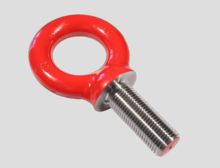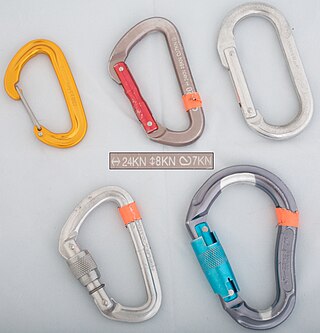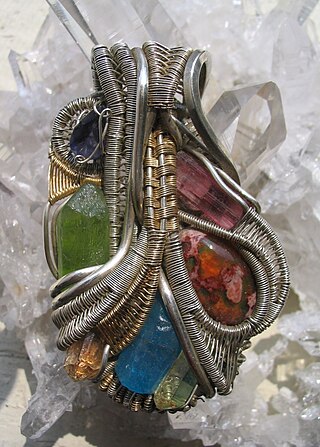
An eye bolt is a bolt with a loop at one end. They are used to firmly attach a securing eye to a structure, so that ropes or cables may then be tied to it.

An eye bolt is a bolt with a loop at one end. They are used to firmly attach a securing eye to a structure, so that ropes or cables may then be tied to it.

Machinery eye bolts are fully threaded and may have a collar, making them suitable for use with angular loads up to 45°. Eye bolts without a shoulder should not be used for angular loads.
Heavy forged eye bolts with a continuous eye may be forged with an integral shoulder, allowing their use for heavy off-axis loads.

Eye bolts are often installed into masonry and so versions that form their own anchor bolt are commonly available. Most of these screw into some form of shield anchor. Some lightweight forms are not screwed, but rely on just the pull on the ring itself to expand the anchor.
A ring bolt is an eye bolt with a captive ring passing through it. [1] The loose ring is articulated, such that it can rotate in at least one axis, and can thus reduce bending forces on the bolt when loaded and will present the minimum obstruction when "flat".

Screw eyes are a screw with a loop on one end and threads on the other end. Screw eyes are commonly used to attach cables to objects, for instance attaching a string to the back of a painting to allow the painting to hang from a nail on a wall. Long-shanked screw eyes are termed 'vine eyes' and are used to attach support wires to wooden fence posts when growing soft fruit or grape vines, the plants then being tied to the wires.
Wire eye lags (also called screw thread eye bolts, eye screws, or turned/bent eye lags) have a wood screw thread for use in wood or lag anchors. Like wire eye bolts, wire eye lags are intended for light duty applications and should not be used for angular loads.
Eye bolts made by bending a rod or wire into a loop are only suitable for light duty applications, as heavy loads can cause the eye to open. For high loads, eye bolts with forged or welded loops should be chosen, as they can withstand loads up to the tensile strength of the material of which they are made.

'Pigtail' eye bolts are a form of bent loop where the ends are not closed, but multiple turns are used to prevent a rope slipping out. They allow a rope to be threaded into the loop, even if its ends are already attached elsewhere.
Feminist artist Sheila Levrant de Bretteville designed a necklace of an eye bolt on a chain, meant to represent "strength without a fist"; she gave the first of these to Arlene Raven and Judy Chicago when they started the Feminist Studio Workshop in 1972. [2] [3] Since then she has given them to other women with whom she shares a vision of the creation of women's culture. [2] Members of the Feminist Studio Workshop of 1978-79 also made 500 of these necklaces to celebrate the 5th anniversary of the Woman's Building in Los Angeles. [lower-roman 1] [2] The feminist art group Sisters of Jam (Mikaela & Moa Krestesen) turned the necklace into a mobile monument; they see the eye bolt "as a symbol for the work already done but also as an encouragement for the work that is not yet completed." [3] Sisters of Jam also did the installation "Hello Sheila", which features an eyebolt on a chain, at the Survival Kit Festival in Umeå in 2014.

A carabiner or karabiner, often shortened to biner or to crab, colloquially known as a (climbing) clip, is a specialized type of shackle, a metal loop with a spring-loaded gate used to quickly and reversibly connect components, most notably in safety-critical systems. The word comes from the German Karabiner, short for Karabinerhaken, meaning "carbine rifle hook" used by a carbine rifleman, or carabinier, to attach his carbine to a belt or bandolier.

A shackle, also known as a gyve, is a U-shaped piece of metal secured with a clevis pin or bolt across the opening, or a hinged metal loop secured with a quick-release locking pin mechanism. The term also applies to handcuffs and other similarly conceived restraint devices that function in a similar manner. Shackles are the primary connecting link in all manner of rigging systems, from boats and ships to industrial crane rigging, as they allow different rigging subsets to be connected or disconnected quickly. A shackle is also the similarly shaped piece of metal used with a locking mechanism in padlocks. A carabiner is a type of shackle used in mountaineering.

A quickdraw is a piece of climbing equipment used by rock and ice climbers to allow the climbing rope to run freely through protection such as bolt anchors or other traditional gear while leading.

Glossary of climbing terms relates to rock climbing, mountaineering, and to ice climbing.

Rock-climbing equipment varies with the type of climbing undertaken. Bouldering needs the least equipment outside of shoes and chalk and optional crash pads. Sport climbing adds ropes, harnesses, belay devices, and quickdraws to clip into pre-drilled bolts. Traditional climbing adds the need for carrying a "rack" of temporary passive and active protection devices. Multi-pitch climbing adds devices to assist in ascending and descending fixed ropes. And finally aid climbing uses unique equipment.
A turnbuckle, stretching screw or bottlescrew is a device for adjusting the tension or length of ropes, cables, tie rods, and other tensioning systems. It normally consists of two threaded eye bolts, one screwed into each end of a small metal frame, one with a conventional right-hand thread and the other with a left-hand thread. The tension can be adjusted by rotating the frame, which causes both eye bolts to be screwed in or out simultaneously, without twisting the eye bolts or attached cables.

The Cat's paw is a knot used for connecting a rope to an object. It is very similar to the cow hitch except there is an additional twist on each side of the bight, making it less prone to slipping.
The cat's-paw is the common hook hitch for slings. It is the same basic form as the bale sling hitch but has additional twists. Brady says "two or three altogether," and Steel, who mentioned the name in 1794, says "three twists." It is the best of all sling hitches and is often recommended for a slippery rope. But no hitch can slip when tied in a slings since it has no ends. All that is needed is a hitch that cannot jam, and this requirement the cat's-paw fills admirably. The knot spills instantly when removed from the hook. It is the hitch always used for heavy lifts.

A fastener or fastening is a hardware device that mechanically joins or affixes two or more objects together. In general, fasteners are used to create non-permanent joints; that is, joints that can be removed or dismantled without damaging the joining components. Steel fasteners are usually made of stainless steel, carbon steel, or alloy steel.

A fish hook or fishhook, formerly also called angle, is a hook used to catch fish either by piercing and embedding onto the inside of the fish mouth (angling) or, more rarely, by impaling and snagging the external fish body. Fish hooks are normally attached to a line, which tethers the target fish to the angler for retrieval, and are typically dressed with some form of bait or lure that entices the fish to swallow the hook out of its own natural instinct to forage or hunt.

A guy-wire, guy-line, guy-rope, down guy, or stay, also called simply a guy, is a tensioned cable designed to add stability to a freestanding structure. They are used commonly for ship masts, radio masts, wind turbines, utility poles, and tents. A thin vertical mast supported by guy wires is called a guyed mast. Structures that support antennas are frequently of a lattice construction and are called "towers". One end of the guy is attached to the structure, and the other is anchored to the ground at some distance from the mast or tower base. The tension in the diagonal guy-wire, combined with the compression and buckling strength of the structure, allows the structure to withstand lateral loads such as wind or the weight of cantilevered structures. They are installed radially, usually at equal angles about the structure, in trios and quads. As the tower leans a bit due to the wind force, the increased guy tension is resolved into a compression force in the tower or mast and a lateral force that resists the wind load. For example, antenna masts are often held up by three guy-wires at 120° angles. Structures with predictable lateral loads, such as electrical utility poles, may require only a single guy-wire to offset the lateral pull of the electrical wires, at a spot where the wires change direction.

A mandrel, mandril, or arbor is a tapered tool against which material can be forged, pressed, stretched or shaped, or a flanged or tapered or threaded bar that grips a workpiece to be machined in a lathe. A flanged mandrel is a parallel bar of a specific diameter with an integral flange towards one end, and threaded at the opposite end. Work is gripped between the flange and a nut on the thread. A tapered mandrel has a taper of approximately 0.005 inches per foot and is designed to hold work by being driven into an accurate hole on the work, gripping the work by friction. A threaded mandrel may have a male or female thread, and work which has an opposing thread is screwed onto the mandrel.

A hose clamp (hose clip,hose lock or Jubilee Clip (UK)) is a device used to attach and seal a hose onto a fitting such as a barb or nipple.

Wire rope is composed of as few as two solid, metal wires twisted into a helix that forms a composite rope, in a pattern known as laid rope. Larger diameter wire rope consists of multiple strands of such laid rope in a pattern known as cable laid. Manufactured using an industrial machine known as a strander, the wires are fed through a series of barrels and spun into their final composite orientation.

The eye splice is a method of creating a permanent loop in the end of a rope by means of rope splicing.

Anchor bolts are used to connect structural and non-structural elements to concrete. The connection can be made by a variety of different components: anchor bolts, steel plates, or stiffeners. Anchor bolts transfer different types of load: tension forces and shear forces.

Wire wrapping is one of the oldest techniques for making handmade jewelry. This technique is done with jewelry wire and findings similar to wire to make components. Wire components are then connected to one another using mechanical techniques with no soldering or heating of the wire. Frequently, in this approach, a wire is bent into a loop or other decorative shape and then the wire is wrapped around itself to finish the wire component. This makes the loop or decorative shape permanent. The technique of wrapping wire around itself gives this craft its name of wire wrapping.

A screw and a bolt are similar types of fastener typically made of metal and characterized by a helical ridge, called a male thread.

A bolt is a form of threaded fastener with an external male thread requiring a matching pre-formed female thread such as a nut. Bolts are very closely related to screws.

A hook is a tool consisting of a length of material, typically metal, that contains a portion that is curved/bent back or has a deeply grooved indentation, which serves to grab, latch or in any way attach itself onto another object. The hook's design allows traction forces to be relayed through the curved/indented portion to and from the proximal end of the hook, which is either a straight shaft or a ring for attachment to a thread, rope or chain, providing a reversible attachment between two objects.

A bolt snap is a type of snap hook with a manually operated bolt action slide gate of medium security used to clip a light load to a ring, eye, loop or bight to temporarily secure or suspend an object. They are used for a wide variety of applications including dog leads and for clipping scuba equipment to the diving harness. A similar but more secure device used to attach sails to a stay is known as a piston hank. It differs from a snap shackle in that the load is not carried by the gate. The bolt snap must be actively operated by the user to clip or unclip, and is not easily snagged or unintentionally clipped or unclipped by pressing or bumping against the surroundings.